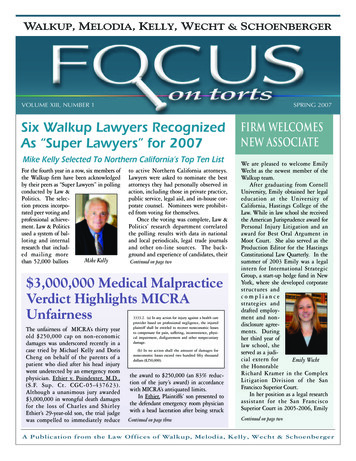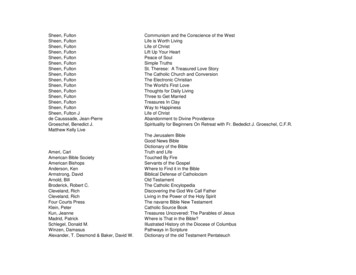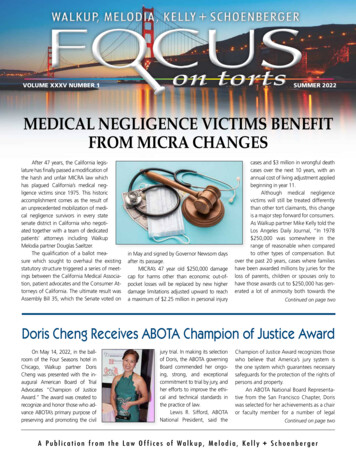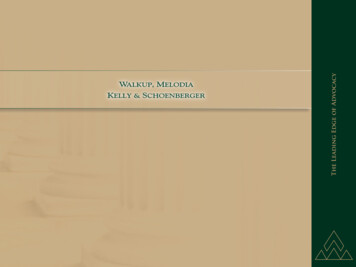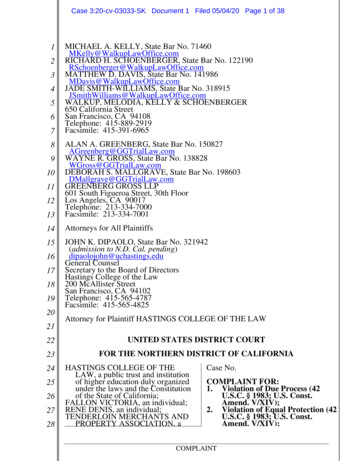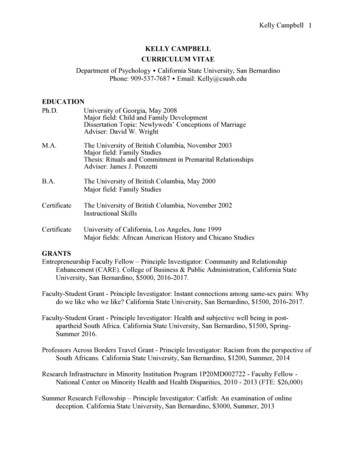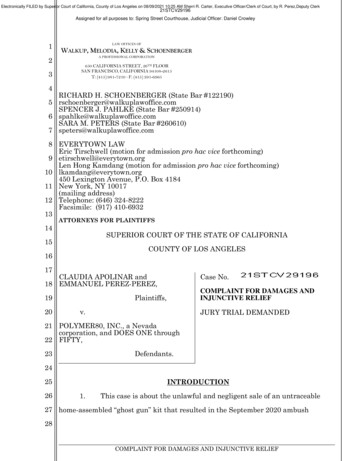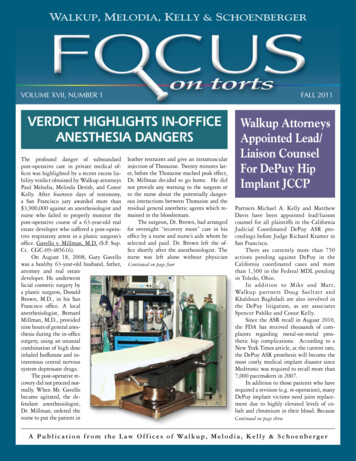
Transcription
WALKUP, MELODIA, KELLY & SCHOENBERGERWALKUP, MELODIAWalkup AttorneysKELLY & SCHOENBERGERThe profound danger of substandardpost-operative care in private medical offices was highlighted by a recent excess liability verdict obtained by Walkup attorneysPaul Melodia, Melinda Derish, and ConorKelly. After fourteen days of testimony,a San Francisco jury awarded more than 3,900,000 against an anesthesiologist andnurse who failed to properly monitor thepost-operative course of a 63-year-old realestate developer who suffered a post-operative respiratory arrest in a plastic surgeon’soffice. Gavello v. Millman, M.D. (S.F. Sup.Ct. CGC-09-485616).On August 18, 2008, Gary Gavellowas a healthy 63-year-old husband, father,attorney and real estatedeveloper. He underwentfacial cosmetic surgery bya plastic surgeon, DonaldBrown, M.D., in his SanFrancisco office. A localanesthesiologist, BernardMillman, M.D., providednine hours of general anesthesia during the in-officesurgery, using an unusualcombination of high doseinhaled Isoflurane and intravenous central nervoussystem depressant drugs.The post-operative recovery did not proceed normally. When Mr. Gavellobecame agitated, the defendant anesthesiologist,Dr. Millman, ordered thenurse to put the patient inleather restraints and give an intramuscularinjection of Thorazine. Twenty minutes later, before the Thorazine reached peak effect,Dr. Millman decided to go home. He didnot provide any warning to the surgeon orto the nurse about the potentially dangerous interactions between Thorazine and theresidual general anesthetic agents which remained in the bloodstream.The surgeon, Dr. Brown, had arrangedfor overnight “recovery room” care in hisoffice by a nurse and nurse’s aide whom heselected and paid. Dr. Brown left the office shortly after the anesthesiologist. Thenurse was left alone without physicianContinued on page fourAppointed Lead/Liaison CounselFor DePuy HipImplant JCCPPartners Michael A. Kelly and MatthewDavis have been appointed lead/liaisoncounsel for all plaintiffs in the CaliforniaJudicial Coordinated DePuy ASR proceedings before Judge Richard Kramer inSan Francisco.There are currently more than 750actions pending against DePuy in theCalifornia coordinated cases and morethan 1,300 in the Federal MDL pendingin Toledo, Ohio.In addition to Mike and Matt,Walkup partners Doug Saeltzer andKhaldoun Baghdadi are also involved inthe DePuy litigation, as are associatesSpencer Pahlke and Conor Kelly.Since the ASR recall in August 2010,the FDA has received thousands of complaints regarding metal-on-metal prosthetic hip complications. According to aNew York Times article, at the current rate,the DePuy ASR prosthesis will become themost costly medical implant disaster sinceMedtronic was required to recall more than7,000 pacemakers in 2007.In addition to those patients who haverequired a revision (e.g. re-operation), manyDePuy implant victims need joint replacement due to highly elevated levels of cobalt and chromium in their blood. BecauseContinued on page threeA P u b l i c a t i o n f r o m t h e L a w O f f i c e s o f Wa l k u p , M e l o d i a , K e l l y & S c h o e n b e r g e r
Supreme Court Creates More Questions ThanAnswers With Howell DecisionFor more than 100 years the collateral source rule had been held sacredby the California Supreme Court(Helfend v. Southern California Rapid Transit District (1970) 2 Cal.3d.1.) It said that if a plaintiff had thegood sense to purchase medical insurance, any defendant who harmedthe plaintiff could not get the benefit of that prudence and thrift by obtaining an offset from the plaintiff’sdamages for the amount covered bythe plaintiff’s insurance. The rationale is simple: as between an innocent plaintiff who has been injuredand a wrong-doing tortfeasor, theone who should benefit from themedical insurance is the person who paidthe premiums for it – whose work, thriftand foresight provided the advantage – andnot the defendant who caused the injury.Not anymore. The verdict is in andinsurance companies and corporations havedeclared victory. In Howell v. HamiltonMeats & Provisions, Inc., the California Supreme Court has held that in a personal injury action in which the plaintiff has privatehealth insurance, the negotiated rate differential (or discount received by the plaintiff’s own insurer) is not a benefit within thecollateral source rule, and thus the plaintiffmay not recover the amount of that differential as part of her economic damages forpast medical expenses she incurred. Thedecision was rendered by a court withouta single member who had handled a personal injury case in the last quarter century.Even more interestingly, Presiding JusticeCantil-Sakauye voted with the six justicemajority. Just one year ago, she authoredthe opinion in King v. Willmett for theThird District Court of Appeal and wrote,“We see no basis in the record from whichwe could conclude plaintiff did not incur 169,499.94 (of which 93,213.62 wasthe negotiated rate differential not paidby medical insurance) in past medical expense.” In holding exactly the oppositeas the ruling in Howell, the King courtfound persuasive the Helfend view that “aperson who has invested years of insurancepremiums to assure his medical care shouldreceive the benefits of his thrift.”Plaintiff Howell suffered injuries that resulted in gross medical bills of 189,978.63.The amount paid on those bills, by her insurance carrier and herself, was 59,691.73.Before trial, defendant moved in limine toprohibit plaintiff from showing the totalbilled amount, and instead to show only theamount paid. The trial court denied the motion, holding that any overpayments wouldbe dealt with using a Hanif motion aftertrial. At trial, the jury found for plaintiff,awarding her the full 189,978.63 in pastmedical specials.The Supreme Court’s analysis breaksdown into a discussion of each of the followingissues:(1) Whether Hanif correctly decidedthat a plaintiff may only recover the amountpaid for past medical specials;(2) If Hanif was decided correctly,does it apply in the context of private healthinsurance;(3) If plaintiff may only recover theamount paid on past medical specials, doesthe tortfeasor receive a windfall;(4) Is the negotiated discount betweenhealth insurers and treating providers an insurance benefit?In order, and with often tortured reasoning, the Supreme Court answered eachquestion in such a way as to undermine thecollateral source rule in the context of medical bills. It is impossible to read the opinion without observing the Supreme Court’sobvious anti-consumer slant. As is typicalwith agenda-oriented judicial legislating,twothe justices left common sensein the dust. Although the courtsays “[W]e do not alter the collateral source rule as articulated inHelfend. Rather we conclude thatbecause the plaintiff does not incur liability in the amount of thenegotiated rate differential, whichalso is not paid to or on behalf ofthe plaintiff to cover expenses ofthe plaintiff’s injuries, it simplydoes not come within the rule,”the truth is otherwise.Among the likely, and unfair, ramifications of the opinion,because contractually bargainedfor reduced rates will now be admitted into evidence, pain and sufferingawards for people with no health insurancewill be higher than for people with healthinsurance. And, by allowing only theamount of paid past medical bills to be admitted for purposes of economic damages(when substantial existing case law allowsthe full amount of the bill to be admittedfor purposes of determining non-economicdamages), attorneys for faultless injuredpeople will be forced to decide whethereven making a claim for past medical billsis in the client’s best interest. This Hobson’s choice leaves plaintiffs in untenableand unfair positions.And, most disturbingly, rather thansettle the question by affirming a historicprinciple of California jurisprudence, thedecision has left confusion and uncertaintyin its wake. Does it apply to HMOs orjust PPOs? Self-funded ERISA plans?Future economic damages? If so, how?What about traditional evidentiary requirements of certainty and prohibitionsagainst the mention of insurance of anykind? What will be the rule for healthinsurers who contract for the ability to“balance bill”? How will those bills betreated at trial?Because the decision is so clearly guidedby a pro-business, pro-defendant agenda, itleaves trial courts adrift trying to decipherits far reaching and unanticipated ramifications. There will likely be as many interpretations of this opinion as there are courts. Atthe end of the day? Clear as mud.
For the second time in two years Walkuppartners have been presented with the covetedSan Francisco Trial Lawyers “Trial Lawyer ofthe Year Award.”At a packed Mark Hopkins Hotel ballroom, Rich Schoenberger and Doug Saeltzerreceived the award from last year’s recipient,Mike Kelly. SFTLA Board Members votedthem the award for their outstanding effortsin the matter of Liou v. State of California, ahotly contested dangerous condition of public property trial in San Mateo County whereRich and Doug prevailed against the state andobtained a verdict in excess of 12 million.In their case, Rich and Doug presentedevidence that Caltrans had known for yearsthat marked crosswalks at uncontrolled intersections are dangerous because they givepedestrians a false sense of security. These intersections may be safer without any markedcrosswalk. They showed knowledge of thedangers of such crosswalks dating back to a1972 study which investigated 400 pedestrian accidents over a five-year period in the1960s, and concluded “approximately twiceas many pedestrian accidents (per pedestriancrossing) occur in marked crosswalks as inunmarked crosswalks.”Then in 2002, the Federal HighwayAdministration analyzed more data in areport that concluded markedcrosswalks should not be usedon roadways with four or morelanes that see an average of atleast 15,000 vehicles a day. ElCamino Real, in the area whereLiou was struck, has six lanesof traffic and sees an averageof more than 25,000 vehiclesa day.Schoenberger had previously been nominatedfor the award. This wasSaeltzer’s inaugural nomination. Rich andDoug meshed their complimentary skillsseamlessly in securing justice in this case.We are also proud to report that MikeKelly was presented with the Robert E.Oliphant Service Award, presented by theNational Institute of Trial Advocacy (NITA)at its recent 40th Anniversary Celebration.The award is presented by the NITA Boardof Trustees for service in all areas, includingprogram directorship, public service, teaching and financial support. The award honorsRobert (Bob) Oliphant, NITA’s first Administrator, who taught law at the University ofMinnesota and William Mitchell Law Schoolfor over 35 years.Mike has been active with NITA sincethe mid 1980s. He has served as a facultymember at Regional TrialPrograms in San Francisco,Los Angeles, San Diego,Chicago, New York, Boulder, Albuquerque, and Boston. He has served as a teamleader at NITA’s NationalSkills Program in Boulder on multiple occasions.Beginning ten years ago,Mike assumed responsibilityfor coordinating curriculumat NITA’s Teacher TrainingPrograms. Six years ago, he accepted anappointment to NITA’s Governing Board.We congratulate him on this very special and well-deserved honor.Walkup Attorneys Appointed Lead/Liaison CounselFor DePuy Hip Implant JCCPContinued from page onethe ASR system was marketed followingso-called “510(k)” approval by the FDA,there was no pre-market testing in patientsto measure the potential accumulation ofheavy metals in their blood, nor was thereone or more clinical trials to evaluate theperformance of the devices over an extendedperiod of time in humans.Soft tissue (muscle, fat and tendon)damage caused by excessive metal particlewear has also surfaced as a problem for manypatients. Although the majority of patientsexperience physical pain, other ASR victimshave no pain, but experience permanent softtissue loss which complicates the nature andextent of any revision surgery.Many surgeons have decided to abandon metal-on-metal hips, preferring insteadto utilize less durable, but safer, alternativesincluding plastic or ceramic articulatingparts. Researchers are now suggesting thatall metal-on-metal hips suffer from a generic flaw which results in excessive productionof cobalt and chromium.Our firm has been in the forefront ofthe ASR litigation since 2008, when wefiled the very first cases in California. Ourattorneys have consulted with experts inthe United States, the United Kingdom,Australia and western Europe. We areinvolved in the science, factual discoveryand trial planning for the California venued cases, and are networked with lawyersthreehandling the ones outside of California.We currently have more than 150 casesfiled in the California JCCP.For referring counsel who have beencontacted by ASR victims, we invite youto call Mike, Matt, Doug or Khaldounto explore the potential for association orreferral of these complex medical productliability claims. Our associate and referring counsel are participating in these casesconsistent with the provisions of CaliforniaRule of Professional Conduct 2-200, withthe individual fee-sharing in any case negotiated to reflect the degree of active participation by referring counsel.
San Francisco CourtClosure Averted byJudicial CouncilAfter six weeks of sometimes frantic negotiations, the State Judicial Council votedto loan 2.5 million to the San FranciscoSuperior Court in order to keep eleven civilcourt rooms open. Council members responded to a plea from San Francisco Superior CourtPresiding Judge Katherine Feinstein forsufficient funds to keep open courtroomswhich had been slated for closure.The San Francisco court, which hadissued lay-off notices to more than twohundred employees (including clerks,shorthand reporters, staff attorneys andcommissioners) predicted it would be compelled to close eleven civil departments as ofOctober 1, 2011, leaving litigants potentially stuck in the judicial system for years.The court closures were expected toproduce lengthy delays, perhaps as long asfive years, in obtaining trial dates. Criminalcases would have been given priority becauseof constitutional due process requirements.Even with the emergency loan, the Superior Court budget crunch will be felt bylitigants. As an example, where previouslythere were two law and motion departmentssupported by two discovery commissioners, a50 percent reduction in judicial staffing willsee Judge Harold E. Kahn replacing JudgesPeter Busch and Loretta Giorgi as the solecivil law and motion judge. While in the pastthere were two commissioners assisting withdiscovery matters, those discovery departments have now been eliminated. All commissioners have been terminated. Judge Kahnwill find himself basically handling the workload formerly shared by four judicial officers.It is unknown how discovery and lawand motion scheduling will be affected bythe change. In the recent past, lawyers couldschedule a hearing date for a motion in theSan Francisco Superior Court without firstreserving a date. Now, hearing dates may berationed, allowing only a limited number ofmotions to be argued on any particular date.According to some court observers,this is only the first in a list of “inconveniences” counsel will experience as theslimmed down civil side of the court movesforward with 25 percent less staff and 100percent fewer commissioners.Continued from page onesupervision to watch the patient in an empty office building.About an hour later, Mr. Gavello became agitated again. Pursuant to a listof drugs contained in a set of preprintedpost-operative orders developed by theanesthesiologist and surgeon, the nurseadministered intravenous Thorazine andintramuscular Demerol. These combinedwith the other drugs in the patient’s bloodstream to cause a respiratory arrest. Thenurse was not trained or competent to provide proper bag and mask ventilation withoxygen. She called 911. By the time helparrived, Mr. Gavello had widespread andirreversible anoxic brain damage. He wastransferred to the hospital where he diedthree days later.Mrs. Gavello and her children filed suitfor wrongful death against the surgeon, anesthesiologist and nurse. Paul and Melindaconducted discovery for a year while thephysician defendants tried to blame thedeath entirely upon the nurse who was uninsured. Before trial they propounded CCPsection 998 demands to each physician fortheir respective insurance policy limits.The surgeon settled for his policy limit.The insurance carrier for the anesthesiologist (NORCAL Mutual), however, refusedto offer the anesthesiologist’s 1,000,000policy limit even though the doctor hadgiven his consent to settle.The case proceeded to trial in SanFrancisco Superior Court.Paul, Melinda and Conor persuaded thejury that the anesthesiologist’s negligencedirectly contributed to the respiratory arrest.They argued that it was the responsibility ofthe anesthesiologist to develop and overseea safe and comprehensive plan for the useof the drugs that are used during generalanesthesia and post-operatively. Throughthe testimony of a prominent Stanfordanesthesiologist, they established that thedefendant violated the standard of care bygiving intramuscular Thorazine. His carewas also substandard when he left before hispatient had emerged from anesthesia, andhe breached the standard of care by failingto provide the nurse with instructions forthe safe post-operative medication.They also showed that Dr. Millmanknew about this particular nurse’s peculiar deficiencies. Several years earlier, shefourhad been held 20 percent liable for a deathoccurring in another plastic surgeon’soffice and Dr. Millman had testified as anexpert on her behalf.The jury rejected the anesthesiologist’s argument that he was not responsible for guiding the post-operative drugadministration. They also rejected hisclaim that there was no way for him toanticipate the nurse’s negligence, and thathis actions did not contribute to cause thedeath. After five days of deliberation, thejury assigned 20 percent of liability to theanesthesiologist, 25 percent to the surgeon, and 55 percent to the nurse. Thejury awarded the plaintiffs 3,977,831 indamages, with roughly 75 percent of thatsum reflecting economic damages for theloss of financial support and householdservices caused by Mr. Gavello’s death.After deduction for credit from theprevious recovery and the application ofMICRA, the plaintiffs’ judgment against theanesthesiologist was roughly two and a halftimes his available insurance policy limit.This case highlights the poor performance of California’s Board of Registered Nursing. In the late 1990s, NurseEngle was found 20 percent responsiblefor the death of a young woman in a plasticsurgeon’s office because she failed to monitor the patient’s respiratory status closelyand was unable to provide proper bag andmask ventilation when the patient stoppedbreathing. After receiving a glowing letter of recommendation from Dr. Millman,the defendant anesthesiologist in this case,the nursing board decided to let NurseEngle keep her license. None of this became public record and none of this wasever disclosed to the patient.Mrs. Gavello has been urging the nursing board to do something about this nursefor more than two years. The board has beenprovided with all the materials in this case,including thousands of pages of trial testimony. It has done nothing.California is one of a growing numberof states that now require doctors’ officesto be certified for outpatient surgery, butunfortunately the certification process hasnot plugged the gaping holes in the patientsafety net when it comes to general anesthesia in a doctor’s office.We congratulate Paul, Melinda andConor for this outstanding result.
WALKUPMike Kelly was re-appointed to a new threeyear term on the Judicial Counsel AdvisoryCommittee on Civil Jury Instructions (CACI).On the CLE front, Mike spoke in July at theHarris – Martin DePuy Hip Seminar, togetherwith Mark Robinson of Orange County, onthe topic of trial themes in the DePuy productliability cases. In September Mike co-chaired aCAOC continuing education program focusedon litigating Kaiser claims under the KaiserArbitration system Doug Saeltzer servedas a lecturer at CAOC’s annual auto liabilityseminar at Infineon Raceway on the topic ofHandling Dangerous Roadway cases. In September, Doug managed the “Mighty Mouthpiece Softball Co.” to an unprecedented 4thconsecutive Lawyers League softball title Khaldoun Baghdadi served as Co-Chair ofthe Northern District of California’s LawyerRepresentative Committee to the Ninth Circuit Court of Appeals. He also served as a panelist for the Bar Association of San Francisco’sCLE program on Motions In Limine. Finally,he co-authored (with Andrew McDevitt) aCLE article on Person Most KnowledgeableDepositions Rich Schoenberger returns toteach Advanced Trial Practice at Berkeley LawSchool (Boalt Hall) in the spring. Last monthhe served as Program Director for a NITAU.K. course training solicitors in courtroompersuasion in Belfast, Northern Ireland. Richhas also been elected secretary of the SF Chapter of ABOTA. Spencer Pahlke has accepted a position as a Lecturer at Boalt Hall, wherehe will teach a course in trial advocacy, as wellas continue to serve as the director of Boalt’sexternal trial competitionteams. This past spring heorganized a CLE event foryoung attorneys focusingon how to level the playing field when opposingmore veteran counsel - theevent’s speakers includedleading Bay Area judges,mediators, and attorneys. InSeptember, Spencer organized a CLE event focused Members of the 1995 Mighty Mouthpiece softball team gathered to payon cross-examination, with tribute to the late Hal Stone, sporting his signature red bandanna.the keynote speaker beingMichael Tigar. Paul Melodia participated served as a Team Leader at the 40th anniversaryat an ABOTA “Civility Matters” CLE program NITA National Trial Skills program in Boulin September. The ABOTA civility initiative, der, Colorado. She recently consulted for thestarted in California, is now up and running National Center for State Courts in its bid forin more than 15 states Sara Peters contin- funding advocacy training in a foreign counues her work as co-director of ABC (Attorneys try Melinda Derish serves on the East BayBettering the Community), which this year Community Law Center (EBCLC) Advisorybegan assisting Ala Costa Centers, an after- Board and recently joined its Pro Bono Comschool program for developmentally disabled mittee. Melinda was also honored as a “Risyouth. She is also continuing this year as as- ing Star” by Super Lawyers Magazine. Emilysistant mock trial coach with the Boalt Hall Wecht Polcari gave birth to her first child, atrial teams Andrew McDevitt traveled son, Jack. Baby, mom and dad Mike Polcarito Long Beach to represent the Bar Associa- are doing well. Before departing for maternitytion of San Francisco as a delegate at the an- leave Emily accepted an appointment as anual California Conference of Bar Associations Moot Court instructor at UC Hastings, whose(CCBA). The CCBA brings together volunteer program has been ranked #1 in the nation forattorneys from across the State to promote cre- 2011. She also undertook an appointmentative, non-partisan solutions to law-related is- from the Federal Pro Bono Project of the Sansues for the benefit of Californians. This past Francisco Bar Association to represent a govspring Andrew helped coach the Lowell High ernment employee. Conor Kelly will serve asSchool mock trial team Doris Cheng was an assistant coach for the 2011-2012 UC Hastelected to membership in the San Francisco ings Trial Advocacy Team. In addition, Conorchapter of ABOTA, and selected to the list of announced his engagement to Tanis Leuthold,Northern California’s Top 50 Women Law- a Hastings Class of 2009 classmate. Nuptialsyers by Super Lawyers Magazine. In July, she are planned for summer 2012.In cooperation with the U.S. ConsumerProducts Safety Commission, Battat Inc.has recalled its “Wooden Musical Table”product because of the choking hazard posedto young children by loose or detached pegsin the xylophone-like toy. The table standsabout seven and a half inches tall and combines a xylophone, cymbal, drum and twodrum sticks for use by young children.Little Tykes has expanded its voluntaryrecall of “Little Tykes Workshop and ToolSets” to 1.7 million additional units. 1.6million toy workshops sets and trucks withthe same problem were recalled in August2009. The recalled toy has oversized plastic toy nails that can pose a choking hazard to young children. The nails are threeand one-quarter inches long by one andone-quarter inch in diameter. The company has acknowledged multiple incidentsof children choking on the nails. The toysare manufactured in both the United Statesand in China.Finally, Pottery Barn Kids, a divisionof Williams-Sonoma, is voluntarily recalling roughly 80,000 Sophie and Audrey softdolls. The hair on the dolls may containpoorly secured loops large enough to fitfivearound a child’shead and throat.Additionally,the decorativeheadband onone of the dolls, if loosened, can form a loopwhich fits around a child’s head and neck.Both characteristics pose a strangulationhazard. The company has received multiple reports of problems with the dolls,including one report in which a loop wasfound around the neck of a 21-month oldinfant. The recalled toys are manufacturedin China.
Suit was filed against the tenants as well as the building owner and aproperty management company hired to manage the building. The owner and the property management company claimed that the garbage wasstored in a manner consistent with industry standards. They argued thatthe fire was entirely the fault of the tenants, and that the decedent likelydisarmed the smoke detector in his unit, and that but for that conduct hewould have escaped the building without harm. Mike and Emily demonstrated that garbage storage in the breezeway violated the CaliforniaBuilding Code as well as numerous local code provisions, and that thatthe owner and manager did not comply with non-delegable duties tomaintain the building. The case resolved for the limits of the tenants’ insurance policy, 1,000,000 from the owner’s policy, and 800,000 fromthe property management company’s policy.Boilermaker v. Oil Rig ContractorsIn Boilermaker v. Oil Rig Contractors (No. Dist. Fed. Ct.), Douglas S.Saeltzer and Spencer J. Pahlke reached a confidential seven figure settlement on behalf of a 32-year old boilermaker who received second andthird degree burns on his arm, face, and neck during a “shut down” at alarge Bay Area refinery when the plant was closed for maintenance. Themaintenance project was to run 24 hours a day for two weeks. Because adelay of even one day can cost millions of dollars in lost revenue, timing iskey. On the day of the accident the refinery told plaintiff’s employer thatthe pipe he was to service was cleared and drained. When plaintiff beganopening the pipe he encountered liquid. Plaintiff’s employer testified thatthe refinery assured them that the pipe was drained and to continue. Thedefendant alleged plaintiff was told by his supervisor to stop all work until “flash suits” arrived, that plaintiff ignored this instruction and openeda valve causing hot oily liquid to spray the right side of his body, producing widespread burn injuries. The case settled at mediation following theconclusion of non-expert discovery.Retired Grandmother v. Moon Valley WineryIn Retired Grandmother v. Moon Valley Winery, (confidential countyand case number), Richard Schoenberger, Khaldoun Baghdadi, andSara Peters achieved a 4,750,000 settlement on behalf of a 58-year-oldwoman who was driving to babysit her grandchildren when an undocumented vineyard worker, on his way home from work, lost control onrain-slick asphalt, crossed a double yellow line, and collided with herhead-on. The collision shattered plaintiff’s pelvis, fractured her lumbarspine, lacerated her spleen, herniated her stomach into her chest cavity,and fractured all the metatarsals on her left foot. She spent two monthsin the hospital. The responsible driver had only 50,000 in insurancecoverage. Rich, Khaldoun, and Sara established that the vineyard workers used their vehicles to get from parcel to parcel on the vineyard, whichsaved time and maximized efficiency for the vineyard owner. Utilizingthese facts, they successfully opposed summary judgment on the groundthat the vineyard worker’s commute came within the “implied benefit”exception to the “going and coming” rule. The mediated settlement wasachieved after successfully defeating the vineyard operators’ summaryjudgment motion.Receptionist v. Office Building OwnerIn Receptionist v. Office Building Owner (S.F. Sup. Ct.), Matt Davisand Rich Schoenberger obtained a 4.5 million settlement on behalf ofan 80-year-old woman who attempted to board an elevator and trippedbecause the floor had “misleveled” and was higher than the floor of theadjacent lobby. She fell forward and struck her head on the back of theelevator and suffered partial paralysis as a result. Despite her age, atthe time of her injury she was working as a full-time receptionist. Theinjury happened at her workplace during her morning break. Discoveryrevealed that the elevator system was more than 50 years old and therehad been a number of problems with the elevator in the past. Rich andMatt also discovered correspondence from an elevator consultant whohad warned the building owner several years before the accident that itneeded to modernize the elevators, or risk passengers getting injured andfiling lawsuits. With worker’s compensation benefits, our client’s totalrecovery was 5.3 million.Veterinary Tech v. Winery OwnerIn Veterinary Tech v. Winery
A Publication from the Law Offices of Walkup, Melodia, Kelly & Schoenberger The profound danger of substandard post-operative care in private medical of- fices was highlighted by a recent excess lia- . office. Gavello v. Millman, M.D. (S.F. Sup. Ct. CGC-09-485616). On August 18, 2008, Gary Gavello

